Chinese Name: 平遥古城 Pronunciation: Píngyáo Gǔchéng
Best Visiting Time: All seasons
Suggested Visiting Hours: 1-2 Days
Scenic Area: About 1,260 square kilometers
Building Time: Around 827BC-782BC
Address: Pingyao County, Jinzhong City, Shanxi Province
Building Function: Show people a complete picture of extraordinary cultural, social, economic and religious development.
Popular Activities: Folklore activities include land boat dance, walk on stilts, dragon lanterns, yangko (a popular rural folk dance), etc.
| Attractions | Ticket Fee |
| Ancient City of Pingyao | 125 yuan |
| Shuanglin Temple | 33 yuan |
| Zhenguo Temple | 23 yuan |
1. The ticket fee of Ancient City of Pingyao includes the entrance fee and the fees for other attractions in the scenic area.
2. Shuanglin Temple and Zhenguo Temple are the nearby scenic spots that you cannot miss.
| Attractions | Opening Time | |
| Peak Season (April 1st to October 31st) |
Low Season (November 1st to March 31st) |
|
| Ancient City of Pingyao | 8:00-18:00 | 8:00-17:30 |
| Shuanglin Temple | 8:00-18:00 | 8:00-17:30 |
| Zhenguo Temple | ||
1. Tickets are sold online for 24 hours, and tickets for the day can be purchased before 17:00.
2. The ticket of Ancient City of Pingyao is valid for three days from the date of purchase, and once used, it is non-refundable.
3. Zhenguo Temple and Shuanglin Temple: Tickets are valid for one day.

Pingyao County is a county under the jurisdiction of Jinzhong City, Shanxi Province, with a total area of 1,260 square kilometers and a population of 490,000. The county people’s government is located in Gutao Town. It is the prototype of ancient county towns in Ming and Qing Dynasties(1368-1912) that have been preserved in China.
Pingyao County is located on the east bank of the Fen River and at the southwestern of the Taiyuan Basin, adjacent to Qi County, another national historical and cultural city. Tongpu Railway and Dayun Expressway run through the county. The economy is dominated by agriculture, mainly producing grain, cotton, specialty--Pingyao beef, and lacquerware.
Built in the 14th century, Pingyao is an outstanding example of a well-preserved Han city today. The layout of the town centrally reflects the development of Chinese architecture and urban planning over the past five centuries. It is particularly worth mentioning that the buildings related to the banking industry here are exceptionally majestic because Pingyao was the center of China’s financial industry from the 19th to the early 20th century.
Pingyao County is one of the second batch of famous Chinese historical and cultural cities. On December 3, 1997, the Ancient City of Pingyao was listed as a world cultural heritage by UNESCO. The Ancient City of Pingyao, together with Lijiang in Yunnan Province, Langzhong in Sichuan Province and Shexian County in Anhui Province, is known as “the four most intact ancient cities” in China.
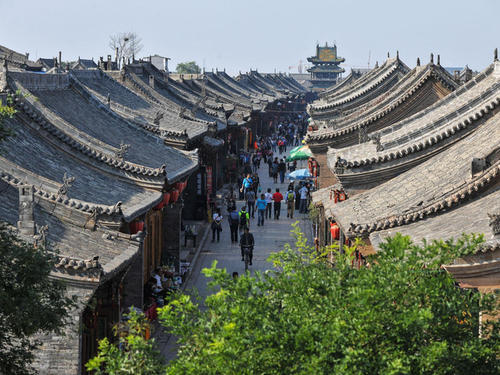
With a history of 2,800 years, Pingyao is the most complete existing ancient county-level city in China. It has been listed on the World Heritage List for all its features, presenting a complete picture of an extraordinary cultural, social, economic and religious development.
The Ancient City of Pingyao was first built during the reign of King Xuan of the Zhou Dynasty between 827 BC and 782 BC for the garrison led by Yin Jifu, a general of the Western Zhou Dynasty.
In the Spring and Autumn Period (770 BC - 476 BC), the Ancient City of Pingyao belonged to the Jin State, and belonged to the Zhao State during the Warring States Period(475 BC - 221 BC).
After the Qin Dynasty((221 BC - 207 BC)) unified China, the system of prefectures and counties was implemented, and Pingyao was established as a county in Taiyuan.
During the Han Dynasty(202-220), Pingyao was successively called Jingling County, Zhongdu County and Wu County.
During the Wei Dynasty(386-534), it was renamed Pingyao County.
In the early years of the Ming Dynasty(1368-1644), the City Wall was built to defend against external disturbances from the south.
In the third year(1370 AD) of Hongwu of Ming Dynasty, the old wall was rebuilt and expanded with bricks covered completely. Later, during the periods of Jingtai, Zhengde, Jiajing, Longqing and Wanli of Ming Dynasty, ten times’ repairs were carried out. The gate towers were renovated and enemy platforms were added.
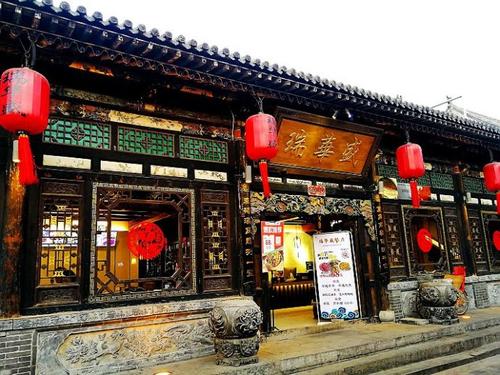
In the 43th year(1703 AD) of Kangxi Reign of Qing Dynasty, the emperor visited Pingyao during his West Travel, so it was at that time that four gate towers were built, which made the Ancient City of Pingyao more spectacular. With a total perimeter of 6,163 meters and a height of about 12 meters, the wall of the Ancient City of Pingyao separates Pingyao County, which covers an area of about 2.25 square kilometers, into two worlds with different styles.
After the seventh year of the Republic of China, roads and railways were constructed one after another, which promoted the opening of Pingyao. A large number of foreign goods flowed into Pingyao and occupied the market. In February 1938, Japanese invaders invaded Pingyao. The ancient city experienced seven years of burning, killing and looting by Japanese fascists. Many buildings were destroyed or converted into military installations. The Japanese invaders implemented an economic blockade policy, and the number of shops in the city was reduced.
After the founding of New China, the People’s Government attached great importance to the protection of the ancient city of Pingyao. In the 1950s and 1960s, funds were allocated for the maintenance of cultural relics and historic sites such as Dacheng Hall of Confucian Temple and Shuanglin Temple.
On May 24, 1965, the Shanxi Provincial People’s Committee announced that the City Wall, Shuanglin Temple, Zhenguo Temple and Dacheng Hall of Confucian Temple were provincial-level cultural relics protection units.
On December 3, 1997, the 21st session of the World Heritage Committee held by UNESCO in Naples, Italy, decided to inscribe the Ancient City of Pingyao on the World Heritage List as a whole. Pingyao Ancient City is a physical specimen for studying the development of politics, economy, culture, art and religion in China.
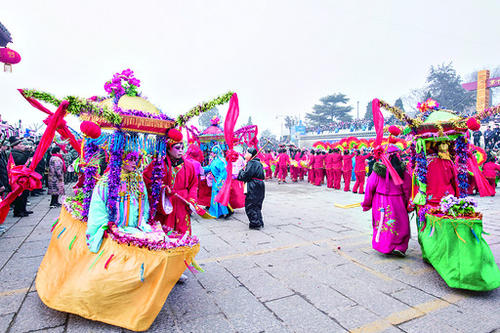
Land Boat is a form of folk art performance of Han nationality. This kind of folk dance is popular in Shanxi during the festivals. This is a dance that imitates the sliding of a boat in the water, usually performed by five or six people.
The performance props are usually colorful boats, decorated with red silk paper flowers, and others are decorated with colored lights and bright mirrors. The middle of the boat is empty for people to stand to show their performances, giving people a sense of sitting in the boat. The boaters mostly play the roles of girls and wives.
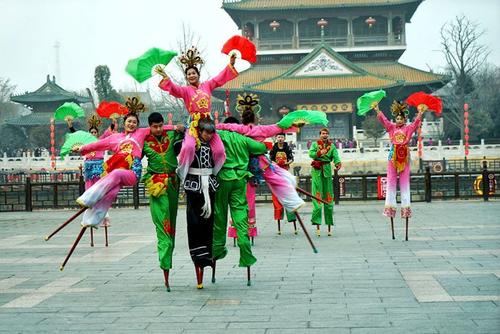
Walking on stilts is one of the traditional folk activities of the Han nationality.
Walking on Stilts, also known as “Gaoqiao”(Chinese pronunciation), “tying high feet” and “walking with high legs”, is a popular folk performance of mass skills. In some folk festivals, dancers tie long stilts on their feet to perform. Walking on stilts is highly skilled, lively and diverse, and is deeply loved by the masses.
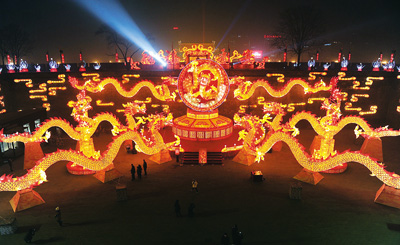
Dragon lantern, also known as dragon dance, is an ancient folk dance of the Han nationality. It reflects the worship of the ancient Han people to the dragon. The body of the dragon lantern is about 20 meters in length and 60 to 70 cm in diameter. The inside is made of iron wire in circle shape, a light bulb or candle is installed, and the outside is wrapped and painted with gauze. The dragon dancers consist of dozens of people. The dragon lantern is a traditional festival lantern of the Han nationality and some ethnic minorities.
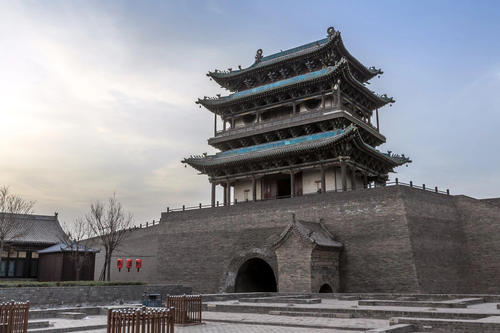
The City Wall of Pingyao was built as a rammed-earth wall during the period of King Xuan of the Western Zhou Dynasty (827 BC ~ 782 BC). In the third year(1370) of Hongwu in the Ming Dynasty, the City Wall was rebuilt and expanded, later the rammed-earth walls were replaced by masonry walls.
The City Wall was repaired 25 times in the Ming and Qing Dynasties. The City Wall is square, with a circumference of 6162.7 meters, a height of 10 meters and a top width of 3 to 5 meters. The wall body is filled with rammed earth and covered with black bricks outside, besides, 77 drainage gutters built by brick on the inner wall.
On the top of the wall, a 2-meter-high crenellation wall was built. There were 3000 crenellations, 72 watchtowers, and a parapet wall inside. There are four corner towers in the four corners. There is a pedestal on the east wall, and Kuixing Tower and Wenchang Pavilion are built on top of the southeast corner.
The City Wall is a kind of large-scale defensive building in ancient China. It has a long history, stable form and unique function. In the five thousand years of historical evolution and civilization development of the Chinese nation, the City Wall, as a unique social form, has played a significant and irreplaceable role in military defense and other aspects.
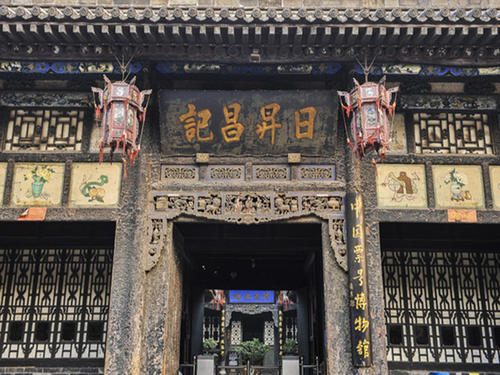
Draft bank (Piaohao) was a private financial institution specializing in the offsite exchange of silver, as well as the business of deposit and loan in the feudal period of China.
Rishengchang(literally translates to “Sunrise Prosperity”) was founded in 1823, and it changed to an old-style Chinese private bank in 1932. After 108 years of operation, it made a profit of 15 million taels of silver. Such a high profit has attracted many businesses to invest in this emerging industry. After the establishment of Rishengchang Draft Bank, a total of 51 banks have been set up across the country, including 43 in Shanxi, of which, 22 in Pingyao.
Rishengchang Draft Bank was co-founded by Li Daquan, a wealthy businessman in Xidapu Village, Pingyao County, Shanxi Province and the general manager Lei Lutai. The head bank of Rishengchang Draft Bank is located at the south of Xidajie Road in the bustling street market in Pingyao County, Shanxi Province. It covers an area of more than 1,600 square meters with compact land utilization and distinct functions.
Rishengchang Draft Bank is the pioneer in China’s national banking industry and once operated the economic lifeblood of the entire Qing Dynasty in the 19th century. Its branches spread across more than 30 cities, as far as Europe, the United States, Southeast Asia and other countries, and is known for “connecting the world”.
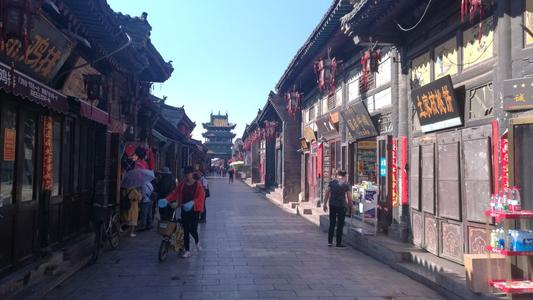
Ming-Qing Old Street (South Street) is located on the central axis of the ancient city of Pingyao. It is one of the most important and prosperous commercial blocks in the ancient city, where the ruins of shops in the Ming and Qing Dynasties are preserved completely. It clearly reflects the glory of the ancient city culture.
There are many shops on this 400-meter-long old street, and 78 ancient shops are closely intertwined, including draft banks, money shops, pawnshops, medicine shops, butcher shops, tobacco shops, grocery shops, silk shops, etc., almost covering all kinds of business at that time. The Shanxi merchants regarded this place as a golden place, and they set up head offices and opened stores here.
Exchange shops such as Baichuantong, Hetongqing, Weishengchang, Weichanghou, Yunjincheng, and Chinese pharmacy Yunjincheng were famous at the time. These shopkeepers received customers in the limited space of the front shop and backyard, and take care of the business. The narrow space attracted visitors from all over the world, and the shopkeepers earned a lot of money.
Shanxi merchants benefited a lot from the prosperity of the market. This small old street has created a large number of commercial talents. If the Shanxi merchants’ large courtyards were the luxurious living quarters of the Shanxi merchants, then we can say that the Ming-Qing Old Street was the place where the Shanxi merchants showed their abilities in business.
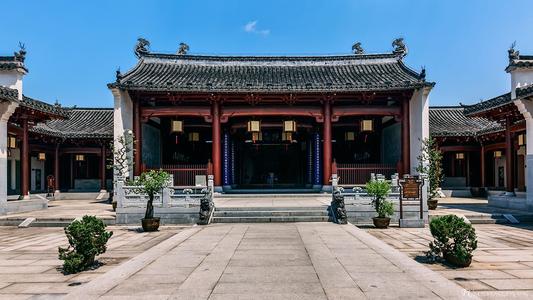
Ancient Government Office of Pingyao, located in the center of the ancient city, was originally built in the Northern Wei Dynasty(386-534) and was finalized in the Yuan, Ming and Qing Dynasties. With a history of more than 600 years, the earliest preserved building was built in the sixth year (1346) of the Yuan Dynasty.
The Ancient Government Office faces south with the axisymmetric arrangement. The length of the north-south axis is over 200 meters and the east-west width is over 100 meters, covering an area of more than 26,000 square meters.
The Ancient Government Office follows the feudal ritual system with civil officials standing on the left and the military officers standing on the right. The front hall of the Ancient Government Office is the court and the backyard is the dormitory. There are six courtyards on the central axis.
As one of the four ancient government offices that have been well-preserved in China, the Ancient Government Office of Pingyao is also the largest one in China. The whole building complex is well-arranged and reasonably structured, which is an organic whole. Whether in terms of architectural layout or function setting, it can be called the epitome of the imperial palace.
On May 19, 2004, the 11th Panchen Lama visited the Ancient Government Office and wrote inscriptions: Ancient Government Office of Pingyao tops all the ancient government offices in China.
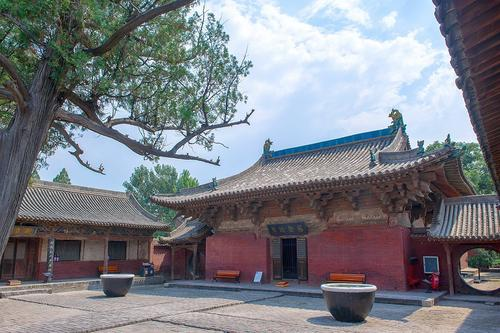
Zhenguo Temple, a national key cultural relic protection unit, is located in Haodong Village, north of Pingyao County, Shanxi Province, 15 kilometers to the northeast of the Ancient City of Pingyao.
Zhenguo Temple was built in the seventh year(963 AD)of the Tianhui Reign of the Northern Han Dynasty and rebuilt in the twenty-first year(1816 AD) of the Jiaqing Reign of Qing Dynasty. There are many inscriptions in the temple, which provide reliable historical evidence for the above content.
Zhenguo Temple, formerly known as “Jingcheng Temple”, was renamed “Zhenguo Temple” during the reign of Emperor Jiajing in the Ming Dynasty(1368-1644) and is still in use today.
The temple is divided into two parts, with a total area of 10,892 square meters. From south to north, there are Tianwang Hall(Heavenly King Hall), Wanfo Hall(Ten-thousand Buddha Hall), and Three Buddha Tower. The Wanfo Hall is the main building in the front yard, which is one of the oldest existing wooden-structure buildings in China. Although the Hall is small in scale, it has a majestic shape and extraordinary momentum. There are 14 colored sculptures in the hall. And in the center of the altar, there is a statue of Sakyamuni. The Buddha is tall and dignified, with a strong style of the Tang Dynasty.
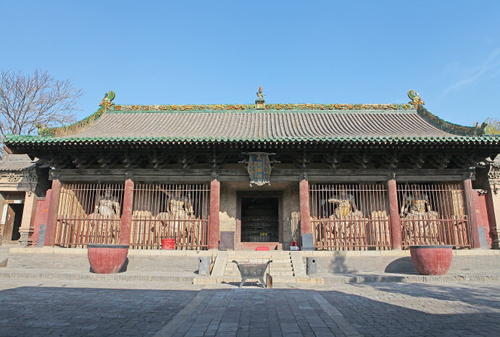
Located in Qiaotou Village, Shuanglin Temple is six kilometers southwest of the Ancient City of Pingyao. It was rebuilt in the second year(571 AD) of Wuping Reign in the Northern Qi Dynasty and was originally named Zhongdu Temple. In the Northern Song Dynasty(960-1127), it was renamed Shuanglin Temple.
In 1988, it was rated as a national key cultural relic protection unit. In 1997, together with the Ancient City of Pingyao and Zhenguo Temple, it was declared as a world cultural heritage.
The whole temple, which faces south, consists of ten halls of different styles and covers an area of more than 15,000 square meters. There are more than 2,000 sculptures in the temple, all of which are made of wood and clay. They absorbed the essence of colored sculptures of the Song, Yuan, Ming and Qing Dynasties, and are called “genuine and unique treasures” by UNESCO.
The Ancient City of Pingyao has a temperate monsoon climate with four distinct seasons and abundant sunshine. Summer is hot and rainy, while winter is cold and dry. January is the coldest month while July is the hottest month. Precipitation varies greatly from year to year and is distributed unevenly throughout the year.
Precipitation is mainly concentrated in June, July, August and September.
Summer is the best time to visit the Ancient City of Pingyao. If you visit the Ancient City of Pingyao in summer, don’t forget to bring an umbrella or raincoat.
Enter from the Gate of the Ancient City of Pingyao→City Wall→Ming-Qing Old Street→Rishengchang Draft Bank→Ancient Government Office→Exit from the Gate→Zhenguo Temple→Shuanglin Temple
It is more convenient to take a taxi to the Ancient City of Pingyao. When taking a taxi, you can use the following sentence to tell the taxi driver the place you want to go.
Chinese: 请带我去平遥古城。English: Please take me to the Gate of Ancient City of Pingyao.
The fare and time spent by taxi from different places in Pingyao to the Ancient City of Pingyao are as follows:
If you go to the Ancient City of Pingyao from Pingyao Railway Station, it takes about 5 minutes (about 6 yuan).
If you go to the Ancient City of Pingyao from Yunjincheng Mansion, it takes about 11 minutes (about 6 yuan).
If you go to the Ancient City of Pingyao from Taiyuan Wusu International Airport, it takes about 1.5 hours (about 200 yuan).
